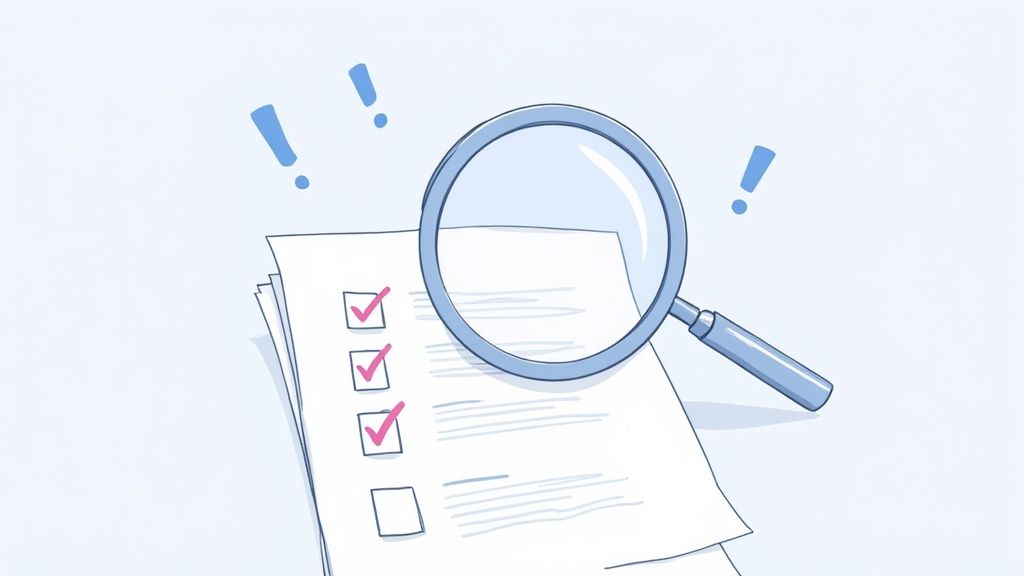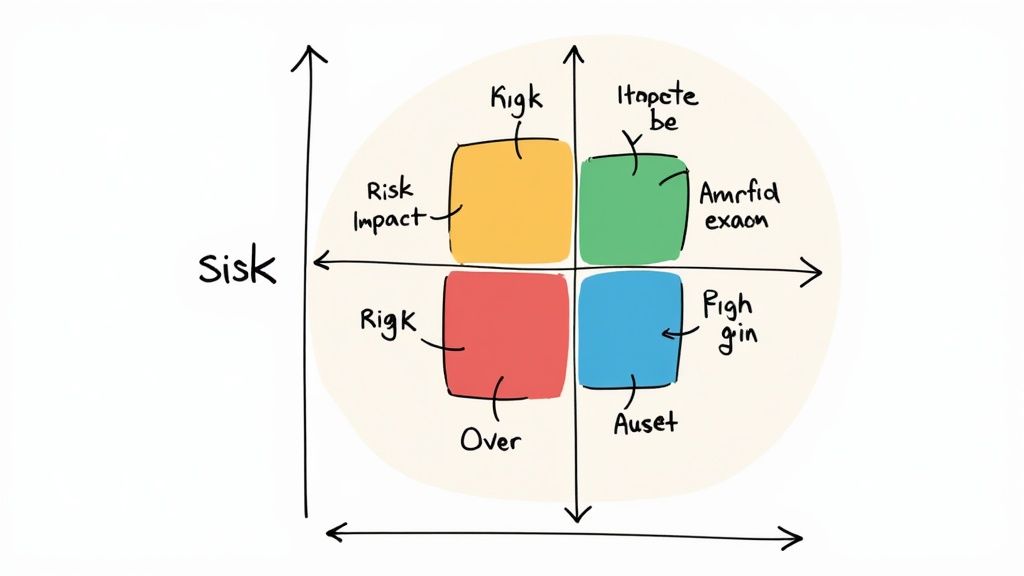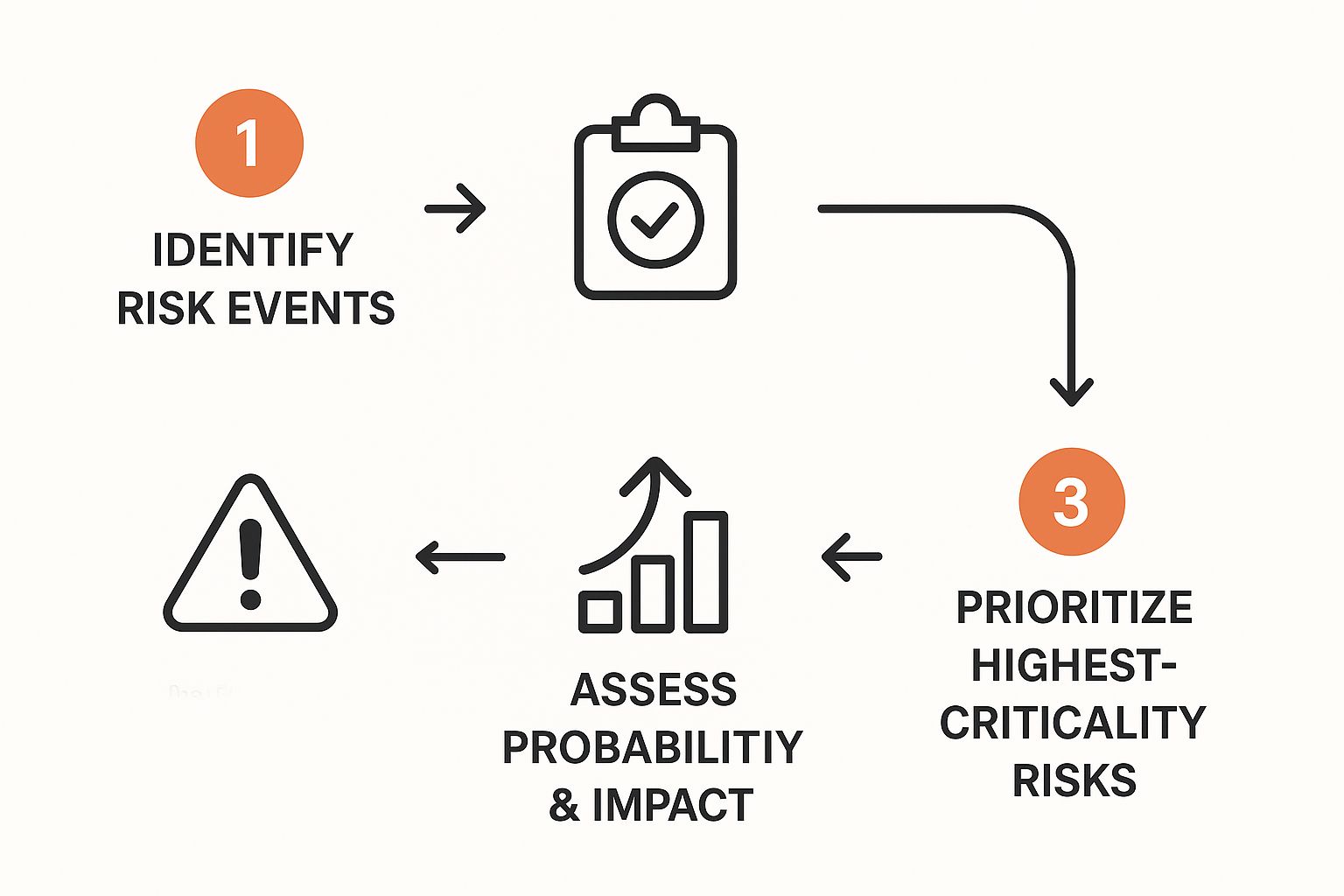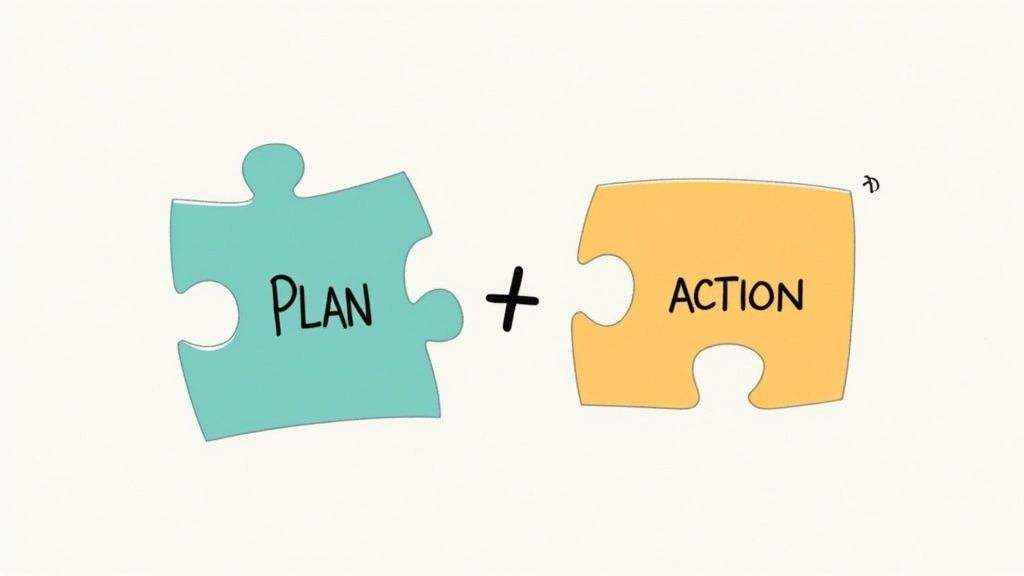Let's be direct: managing risk isn't about creating hefty documents no one reads. It’s a hands-on, practical habit of looking ahead to spot and solve problems before they blow up your project. It's about having a simple, working framework to protect your budget, timeline, and team from "surprises" that were entirely predictable.
Why Practical Risk Management Matters in Your Projects
Projects go off the rails when risks are ignored. This is especially true in fast-moving industries like construction and manufacturing, where old-school, rigid methods for managing risk just don't work. We're talking about the real, tangible difference a forward-thinking approach makes to your bottom line.
This isn't textbook theory. It's about having a straightforward way to see trouble coming and deal with it. I’ve seen a small delay in materials bring an entire production line to a standstill. I’ve watched a single subcontractor no-show throw a multi-week construction schedule into complete chaos. These aren't abstract ideas; they are real-world events with very real costs.
Moving Beyond the Spreadsheet
The goal here is to build a system that actually works in the field, not just in a planning meeting. It needs to be a living, breathing part of your day-to-day operations.
The truth is, risks are more tangled together now than ever before. A recent KPMG report on 'polycrisis' events found that a staggering 93% of international firms took a financial hit from political instability in 2023. It's a stark reminder of how quickly external factors can directly hit our projects. This shows we need to think bigger than just what's happening on our site.
So, what does a practical approach look like on the ground? It comes down to a few core habits:
- Constant Awareness: Making risk a regular, no-fuss talking point in your team huddles and meetings.
- Shared Ownership: Making sure everyone, from the apprentice to the site manager, knows they have a role in spotting and flagging potential issues.
- Simple Documentation: Using tools that are quick to update and easy for everyone to understand. Forget the dense, ten-tab spreadsheets that get ignored after week one.

This image isn't just a stock photo; it’s the heart of good risk management. A site manager and their team on the ground, pointing at the plans, talking through the logistics, this is where you catch problems before they cost you money and time. It’s about using the collective experience of the entire team.
To put this into perspective, let's look at some common risks and what they actually mean for a project.
Common Project Risks and Their Real-World Impact
| Risk Category | Specific Example | Potential Impact |
|---|---|---|
| Supply Chain | A key material supplier goes out of business or faces major shipping delays. | Project halts, budget overruns from sourcing expensive alternatives, and schedule slips. |
| Labour | A critical subcontractor fails to show up on the agreed-upon date. | Delays to the entire project timeline, costly rescheduling of other trades, potential quality issues if a less-qualified replacement is hired quickly. |
| Technical | An unforeseen design flaw is discovered after construction has started. | Costly rework, material waste, and significant schedule delays. Can also lead to safety hazards. |
| Financial | The client is late on a major progress payment. | Cash flow crisis, inability to pay suppliers and subcontractors, and potential for work to stop completely. |
| Safety | An untrained worker operates heavy machinery, leading to a near-miss. | Immediate work stoppage, regulatory investigation, damage to company reputation, and a hit to team morale. |
Seeing these laid out makes it clear that a "small" issue in one area can quickly cascade, affecting every part of the project. This is why a proactive, living risk management process is so critical.
Adopting this mindset transforms risk management from a box-ticking exercise into your most valuable tool for steering a project to a successful finish. It becomes a core part of your operational backbone.
Embedding these practices is fundamental to building a resilient operational system. In fact, it shares a lot of DNA with the principles outlined in the key elements of a health and safety management system. By focusing on what works in the real world, you turn risk management from a chore into a genuine asset.
How to Find What Could Go Wrong
Before you can tackle project risks, you first have to find them. Good risk management starts with getting everything out on the table. This isn't just a quick brainstorm; it’s about systematically digging into what could genuinely derail your project.
A great way to start is by getting the right people in a room. And I don't just mean managers. Your team on the ground, the ones operating the machinery or installing the components, often have the clearest view of potential problems. They see the day-to-day friction points that high-level plans can easily miss.
Collaborative Brainstorming in Action
Get your team together and start a structured conversation. Sometimes, the simplest tools work best. Sticky notes and a whiteboard can be incredibly effective for getting ideas flowing without the pressure of a formal meeting.

This is what a team-based approach looks like in practice. By involving everyone, you get a much richer, more realistic picture of the project's risks, from supplier dependencies to potential skill gaps within the team itself.
To guide the conversation, use simple but powerful "what-if" questions tailored to your environment.
- For a construction site: "What if our primary concrete supplier has a batch recall?" or "What if unseasonal rain floods the site for a week?"
- For a manufacturing floor: "What if our main CNC machine goes down for unscheduled maintenance?" or "What if a critical component from an overseas supplier gets held up in customs?"
These specific scenarios shift the discussion from abstract worries to concrete problems you can actually start planning for.
The goal isn't to create fear or uncertainty. It's to build a shared awareness of the challenges ahead. When everyone contributes to the risk list, they become personally invested in the solutions from day one.
Structuring Your Findings
Once the ideas are flowing, you need a way to organize them. This is where a risk register comes in. And forget complicated software for now; a simple spreadsheet is often all you need. It becomes your single source of truth for all potential issues.
Your initial register should be very simple. At this stage, just focus on capturing the risks. Create columns for:
- Risk ID: A simple number (e.g., 001, 002) to track each item.
- Risk Description: A clear, one-sentence explanation of the potential problem.
- Category: Grouping risks helps you spot trends. Common categories include Financial, Technical, Labour, and Supply Chain.
The next step is to assess these risks, which is a big topic on its own. For a deeper look into how to visually plot these risks based on their potential impact, you can learn more about building a practical risk management matrix. This tool is critical for helping you prioritize what to tackle first.
The key is to keep it simple. A risk register that's easy to understand and quick to update is one that will actually get used. A document that's too detailed just gathers dust.
Assessing Risks Without The Complicated Maths
Once you've got a list of potential problems, the next job is figuring out which ones actually demand your attention. Good risk management isn't about treating every risk the same; it's about sorting them so you can focus your energy where it truly counts.
Forget complex formulas. For most project teams, a simple, qualitative approach is far more practical and gets the job done faster.
The core idea is to look at each risk through two simple lenses: its potential impact if it happens, and its likelihood of happening. This straightforward pairing is all you need to categorize and prioritize your risk register.
A Practical Sorting System
You don’t need fancy software for this. A basic high, medium, and low scale for both impact and likelihood works perfectly fine.
- Impact: How badly will this hurt the project's budget, schedule, or quality? A "high" impact could stop the project cold, while a "low" impact might just be a minor inconvenience.
- Likelihood: How likely is this to actually happen? A "high" likelihood is something you almost expect, while a "low" likelihood is a true long shot.
Combining these two gives you a clear sense of priority. A high-impact, high-likelihood risk is obviously your top concern. On the other side, a low-impact, low-likelihood risk can probably just be put on a watch list without needing a detailed action plan right away.
The infographic below shows how to turn a raw list of risks into a focused action plan.

As you can see, the process moves from broad identification to focused assessment, letting you zero in on the risks that pose the greatest threat.
Using a Simple Risk Matrix
A risk matrix is the best way to visualize all of this. It’s just a simple grid that plots impact against likelihood, often using colors like red, yellow, and green to show severity. This makes your project's risk profile easy for anyone on the team to understand at a glance.

A visual tool like this makes it immediately clear where your "red zone" risks are, helping to focus team discussions on what really matters.
Think about a commercial building project, for instance. A major equipment failure is high-impact but (hopefully) low-likelihood. On the other hand, minor delays in material deliveries might be low-impact but high-likelihood. Seeing them plotted on a matrix helps you decide how to approach each one. You'd want a robust contingency plan for the equipment, but you might just build a small time buffer into the schedule for the material delays.
The point of risk assessment isn't just to label risks. It's to drive a conversation about where to invest your limited time, money, and effort for the biggest protective effect.
The impact of some risks can be catastrophic, leading to projects being paused or cancelled entirely. Just look at Australia's construction sector, where macroeconomic pressures have created serious challenges. In the third quarter of 2024, Victoria saw a residential project abandonment rate of 8.6%, while the NSW/ACT region experienced a 4.6% rate for commercial projects.
You can discover more insights about these construction industry risks to see how larger economic factors play a role. It’s a stark reminder of why it's so important to assess financial and market risks right alongside your operational ones.
Developing Practical Plans to Handle Risks
Spotting and sizing up risks is only half the battle. A risk is just a worry on a spreadsheet until you have a practical plan to deal with it. This is where you transform your analysis into clear, decisive actions for your most serious threats, making your risk management approach a real-world tool, not just another document.
Once you've prioritized your risks, you generally have four ways to tackle them. Picking the right strategy is critical.
- Avoid: Sometimes the best move is to sidestep the risk entirely. If a particular supplier has a reputation for being unreliable, you avoid that risk by choosing a more dependable one from the start. Simple.
- Transfer: This involves shifting the financial impact of a risk to someone else. Think insurance policies or carefully worded contracts with subcontractors that make it clear who is liable if things go wrong.
- Mitigate: This is about reducing the probability or the impact of a risk. For instance, if you're worried about weather delaying a construction project, you could mitigate that risk by pre-fabricating certain components indoors ahead of time.
- Accept: For minor risks, the most sensible option might be to simply do nothing and accept the potential fallout. This is a perfectly valid strategy when the cost and effort to counter the risk would be far more than the potential damage itself.
A plan without an owner is just wishful thinking. The most critical part of this step is assigning a specific person to be responsible for executing each risk response. This creates accountability and ensures someone is ready to act if a risk occurs.
Assigning Clear Ownership
Every single risk response needs a name attached to it. This person is the designated "risk owner." They are on the hook for watching out for risk triggers and kicking the response plan into gear when needed. This isn't about playing the blame game; it’s about clarity and responsibility.
The image below shows this principle in action: a project manager pointing out a specific risk item to a team member. That one-on-one conversation is vital for making sure the risk owner truly understands what's expected of them.

This kind of direct communication ensures the plan isn't just a forgotten line in a spreadsheet. It becomes a concrete task that someone is geared up to handle, even under pressure.
An area where this ownership has become essential is cybersecurity. In Australia, we're seeing a big shift where project managers are now expected to build cyber resilience directly into their project plans. It's no longer a job that's just handed off to the IT department. This reflects a broader need to actively safeguard sensitive project data and protect corporate reputations from ever-present online threats. You can read the full analysis on project management trends to see how this responsibility is evolving.
Keep your response plans simple and to the point. When a problem actually hits, no one has the time or patience to wade through a complicated, 10-page document. A clear, one-paragraph plan is often all you need.
Keeping an Eye on Risks Throughout the Project
Let's be direct: a risk register that just gathers dust in a project folder is completely useless. The real work begins after the initial planning. Managing risk well means making it a living, breathing part of your project's daily rhythm. It’s a constant process of watching, reviewing, and adjusting as things inevitably change on the ground.
You don't need to add another long, formal meeting to everyone's already packed schedule. The most practical way I've found to handle this is to bake a quick risk review into your existing team meetings.
Just set aside 10-15 minutes in your weekly or fortnightly catch-ups to run through the top risks. The conversation should be quick and to the point: "Has anything changed with Risk X? Is our plan for Risk Y still the right one?"
Knowing When to Re-evaluate
Some events are so significant they demand a much deeper look into your risk register, outside of your regular check-ins. These are the moments when the project's entire landscape shifts, and your old assumptions might not hold water anymore.
Be on the lookout for these key triggers:
- A major scope change: The moment a client asks for something new or different, you've introduced a whole new set of potential problems that need to be properly assessed.
- New supplier information: If you get wind that a key supplier is having financial trouble or facing production delays, you have to immediately re-evaluate any risks tied to their performance.
- A near-miss on site: This is a huge red flag. If a problem almost happened, it’s a clear signal that the likelihood of that risk is far higher than you initially thought. It’s a wake-up call to urgently review your response plan.
- External market shifts: A sudden spike in material costs or a new government regulation can have a massive domino effect on your project's budget and timeline.
Here’s an example of a simple project dashboard that helps teams keep track of these key risks in real time.
This kind of visual tool moves risk management out of a static report and transforms it into a dynamic, daily part of running the project.
Keeping Stakeholders Informed
Talking about risks with clients and senior management requires a delicate balance. You need to be transparent without causing unnecessary panic. My advice? Don't just forward them a massive, detailed risk register. They won't read it, and it will only create anxiety.
Instead, provide a concise summary of the top 5-10 risks, their current status, and the clear action plans you have in place to manage them.
When you report a risk, always report the plan to handle it in the same breath. This shows you are in control of the situation, which builds confidence rather than creating anxiety.
This focus on constant monitoring and adaptation is what separates a tick-box exercise from a truly dynamic risk management system. By tracking risk trends and triggers, you can start to see problems coming before they hit.
For those in high-risk industries, this forward-looking approach is critical. Learning more about how predictive analytics can be applied to safety offers a much deeper level of insight. To understand how data can help you stay ahead of potential issues, explore our guide to predictive safety analytics.
Ultimately, the goal is to create a project environment where the entire team is always aware of the current risk landscape and is prepared to act, not just react.
Got Questions About Managing Project Risk?
Even with a solid framework, theory and practice are two different things. Once you start applying risk management on a real project, questions always pop up. Here are some of the most common ones I hear from project managers on the ground, especially in construction and manufacturing, along with some straight-talking answers.
How Much Time Should I Actually Spend on This?
There’s no magic number, but a good rule of thumb is to dedicate around 5% to 10% of your initial project planning time to digging into risks. But don't get too hung up on that number. The real secret isn't a massive upfront effort; it's consistency.
What matters most is making risk management a continuous part of your project’s rhythm. Just build a 15-to-30-minute risk review into your weekly or fortnightly team meetings. For a major construction build, you might schedule a dedicated workshop at key milestones. A little time spent regularly is far more powerful than one big session at the start that everyone forgets about.
How Do I Get My Team to Take Risk Management Seriously?
The quickest way to get your team on board is to make it real for them and get them involved from day one. Don't just hand them a finished risk register and expect them to care. You have to bring them into the process.
Ask direct questions that connect to their daily work:
- "What's the one thing that keeps you up at night on this job?"
- "What could completely derail your part of the project next month?"
- "If something goes sideways, what's the most likely culprit?"
When your crew sees their own concerns written down, taken seriously, and actually addressed, they start to own it. The other critical move is assigning a clear owner to each risk response plan. When someone's name is next to it, they're naturally more invested in seeing it through.
And finally, share the wins. When a plan works and you successfully dodge a bullet, celebrate it with the team. It's the most powerful way to prove the real-world value of what you're doing.
My Project Is Already Underway. Is It Too Late to Start?
Absolutely not. It's never too late to start managing risk. In fact, starting mid-project can be incredibly effective because you’re not dealing with hypotheticals anymore. You have real-world data and recent experiences to draw from. You've probably already hit a few unexpected hurdles.
Kick things off by documenting those recent problems. What happened? What caused them? This gives you an instant, battle-tested list of risks to work with. From there, get the team together for a quick huddle to identify what other storm clouds might be on the horizon for the next phase.
You don’t need to do a massive, backward-looking analysis. Just focus your energy on the work that’s still ahead. A simple, forward-looking risk plan created today is infinitely better than having no plan at all for the rest of the project.
What on Earth Is a Risk Register? Does It Need to Be Complicated?
A risk register is just a formal name for your project's list of identified risks. And no, it absolutely does not need to be complicated. Forget the fancy software or convoluted templates you might have seen. At its heart, it can be a simple spreadsheet.
To be genuinely useful, a risk register only needs a few key columns:
- Risk Description: A short, clear sentence on the potential problem.
- Impact: How bad will it be? A simple rating like high, medium, or low works perfectly.
- Likelihood: How likely is it to happen? Again, high, medium, or low is all you need.
- Response Plan: What's our move? A brief outline of how you'll handle it.
- Owner: Who's responsible for making sure the plan happens?
The goal here is clarity, not complexity. A one-page register that your team actually looks at and uses is far more valuable than a 50-page document collecting digital dust on a server. Start simple. You can always add more detail later if the project truly demands it. The whole point of the tool is to make managing risk an organized, straightforward task for everyone involved.
Are you tired of juggling spreadsheets, paper forms, and endless email chains to manage your project risks and safety compliance? Safety Space replaces the clutter with one simple, powerful platform. See how you can get real-time oversight, simplify your processes, and spot problems before they escalate by booking your free, no-obligation demo at https://safetyspace.co.
Ready to Transform Your Safety Management?
Discover how Safety Space can help you build a safer, more compliant workplace with our comprehensive safety management platform.
Book a Free DemoRelated Topics
Safety Space Features
Explore all the AI-powered features that make Safety Space the complete workplace safety solution.
Articles & Resources
Explore our complete collection of workplace safety articles, tools, and resources.
